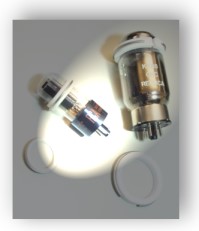Duende Criature Tube Rings
Published at HiFi+ issue 28,
by Roy Gregory

Tube dampers:
an ever present in the tweeker's armoury, but one with a distinctly chequered past.
Who can forget those Sorbothane damping rings that melted over time and slithered down the tube to contaminate the pins and sockets?
Indeed,tube damping seems to have been an open invitation to every audio inventor out there, each looking to invent a better mousetrap. Why? Because the mechanical damping of tubes delivers a clearly audible advantage. It only takes a quick AB comparison to convince even the most sceptical of listeners, and if it's your baby/invention/device doing the damping then it's hard to resist the conclusion that a grateful audio world is going to beat a path to your door. But you couldn't be more wrong.
There are a number of problems with damping valves, not the least of which is the relatively small number of people who actually run valve amplification, (you can forget guitarists, perhaps the biggest potential market, on the basis that they actually WANT distortion!)
But the next problem is consistency, It's easy to make a damping device that works short-term. It's harder to maintain that effect over a period of months or years. Finally there are the practical issues of size and cost. Most thermionic amplifiers use enough tubes and pack them tightly enough together that any-thing bulky or expensive becomes self-defeating.
To date, I've only found two valve dampers that actually deliver sonically and in terms of longevity. One is the Sicomin damper, a small composite sleeve that fits over pre-amp valves like ECC83s (or EL84 output tubes - but they're the exception). It certainly works and goes on working. The problem is that they're not cheap and as far as I'm aware, they only come in the smaller diameter. This lack of definite knowledge is the other problem. I got mine some ten years ago. I don't know if they come in larger sizes or not,or if they're even still available.
My other success story is the Pearl Valve Cooler, a metal concertina sleeve that clamps over your valve, held in place with a rubber 0 ring round its circumference. These are claimed to mechanically damp your tube (in which regard they are spectacularly successful) and increase its life span by allowing it to run cooler (on which subject I have no evidence). The problems with the Pearl were simple. Standing out a centimeter or more from the circumference of the valve, actually fitting them was a problem in many cases. The company suggested that in tight installations you could actually dispense with the 0 ring and interleave the fins of the coolers, almost like the teeth of cogs. Unfortunately devoid of the clamping ring the coolers simply rattled against the valve, actually making the sound worse.
The other issue was the rubber 0 rings themselves: The heat from the valves caused them to break,thus leaving you with an undamped damper. This made regular inspection and replacement essential,which was a real pain if you are talking about an enclosed chassis or pre-amp. Nevertheless, if you could put up with the hassle then the Pearls were the best show in town,and they're still available from Moth Marketing Tel. (44)(0)1234-741152, www.mothgroup.com).
However, trawling round the Frankfurt show this year, I came across a new damper, stunning in its simplicity, dramatic in its effect. Manufactured by Duende Criatura in Holland, and named simply Tube Rings, these are Teflon hoops that are slit so that they can be expanded to fit over a valve bottle. There's a groove around the outside and this locates a titanium C spring to provide the necessary clamping tension. They are manufact-ured in eight standard sizes and fitting is simplicity itself. You just slide the ring over the top.
Prices and Sizes
Diameter Tube Types
9-10mm 6021W, 6111WA etc
19-22mm ECC83, EL84 etc
26-29mm 6SN7 etc
27-32mm EL34, 5AR4 etc
36-39mm KT90, 6L6GC etc
39-42mm 2A3, 300B etc
44-48mm KT66, KT88, 6550 etc
53-58mm 211, 845, 813 etc
Note - all prices in Euros. Rings are supplied in packs of two. Special Sizes can be produced at the same price as the next Size up of the tube and position it level with the top-plate of the internal metalwork. Once in place they stay put, and recent substitution of brand new samples for ones that have been in use for a good six months produced no identifiable difference in effect, which bodies well for longevity. Indeed, the only real limitation on their use is that the valves involved must have parallel sides.
In use, the benefits of the Tube Rings are sonically on a par with the Pearls (although without any cooling benefits). You get crisper and greater dynamic range, a blacker background, better focus, deeper and more powerful bass. In fact, all the things you'd expect from a good valve damper. But it's the magnitude of the differences that really impresses. You'll not be straining to hear them and they are both musically significant and hi-fi relevant. The sheer increase in clarity and separation makes it far easier to hear exactly what is going on within the music, while the increased dynamic range, control and discrimination make performances much more expressive, involving and realistic. Even CB, a notorious sceptic when it comes to such devices, was left open-mouthed with surprise when I demonstrated their effect on the Audiopax amps. Not bad for such a simple, cheap and trouble free tweek
I think you'll agree Anybody with a tube amp, especially an open chassis model should investigate these plain looking little rings immediately. The fact that you'll probably be getting them mail order means that you can try them safe in the knowledge that you can return them if unconvinced, but somehow, I think you'll be keeping them once you hear the effects. They're now considered essential as far as I'm concerned, and bring new meaning to the term 'Simply The Best'.